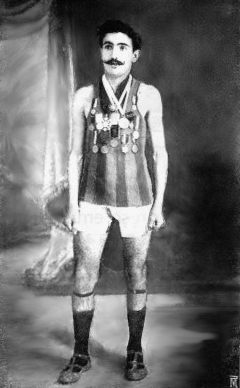Francisco Lázaro on:
[Wikipedia]
[Google]
[Amazon]
Francisco Lázaro (21 January 1888 – 15 July 1912) was a Portuguese Olympic
"''The Piano Cemetery'' by José Luís Peixoto – review"
''The Guardian'', 19 February 2011.
 Lázaro appears briefly in the film ''The Games of the V Olympiad Stockholm, 1912'', which also noted his death.
Lázaro appears briefly in the film ''The Games of the V Olympiad Stockholm, 1912'', which also noted his death.
marathon
The marathon is a long-distance foot race with a distance of kilometres ( 26 mi 385 yd), usually run as a road race, but the distance can be covered on trail routes. The marathon can be completed by running or with a run/walk strategy. There ...
runner and Portugal's standard-bearer
A standard-bearer, also known as a colour-bearer or flag-bearer, is a person who bears an emblem known as a standard or military colours, i.e. either a type of flag or an inflexible but mobile image, which is used (and often honoured) as ...
in their first-ever participation at the Olympic Games, the 1912 Summer Olympics
The 1912 Summer Olympics (), officially known as the Games of the V Olympiad () and commonly known as Stockholm 1912, were an international multi-sport event held in Stockholm, Sweden, between 6 July and 22 July 1912. The opening ceremony was he ...
in Stockholm
Stockholm (; ) is the Capital city, capital and List of urban areas in Sweden by population, most populous city of Sweden, as well as the List of urban areas in the Nordic countries, largest urban area in the Nordic countries. Approximately ...
, Sweden.
Career
Like all the Olympic athletes of his time, Lázaro was anamateur
An amateur () is generally considered a person who pursues an avocation independent from their source of income. Amateurs and their pursuits are also described as popular, informal, autodidacticism, self-taught, user-generated, do it yourself, DI ...
sportsman. His actual job was as a carpenter in an automobile factory in Lisbon
Lisbon ( ; ) is the capital and largest city of Portugal, with an estimated population of 567,131, as of 2023, within its administrative limits and 3,028,000 within the Lisbon Metropolitan Area, metropolis, as of 2025. Lisbon is mainlan ...
. Prior to the Olympics, he had won three national marathon championships in Portugal, where he represented S.L. Benfica.
Lázaro was the first athlete to die during a modern Olympic event after collapsing at the 30-kilometer mark (19 miles) of the marathon with a body temperature of 41 °C (105.8°F). He was initially thought to have died of severe dehydration
In physiology, dehydration is a lack of total body water that disrupts metabolic processes. It occurs when free water loss exceeds intake, often resulting from excessive sweating, health conditions, or inadequate consumption of water. Mild deh ...
due to the high temperature registered at the time of the race. It was later discovered that Lázaro had covered large portions of his body with suet
Suet ( ) is the raw, hard fat of beef, lamb or mutton found around the loins and kidneys.
Suet has a melting point of between and solidification (or congelation) between . Its high smoke point makes it ideal for deep frying and pastr ...
to prevent sunburn
Sunburn is a form of radiation burn that affects living tissue, such as skin, that results from an overexposure to ultraviolet (UV) radiation, usually from the Sun. Common symptoms in humans and other animals include red or reddish skin tha ...
and to help with speed and lightness while running, but eventually, the wax restricted the athlete's natural perspiration
Perspiration, also known as sweat, is the fluid secreted by sweat glands in the skin of mammals.
Two types of sweat glands can be found in humans: eccrine glands and Apocrine sweat gland, apocrine glands. The eccrine sweat glands are distribu ...
, leading to a fatal body fluid electrolyte imbalance
Electrolyte imbalance, or water-electrolyte imbalance, is an abnormality in the concentration of electrolytes in the body. Electrolytes play a vital role in maintaining homeostasis in the body. They help to regulate heart and neurological function ...
. Before the race, he had supposedly said: "Either I win or I die."
The following weekend, a memorial service for Lázaro was attended by 23,000 people at the Olympic Stadium. Approximately US$3,800 () was collected for his wife, and later a monument of Lázaro was placed at the marathon's turning point at Sollentuna, Stockholm. His name was given to a street in Lisbon and the home stadium of football club C.F. Benfica. The novel ''The Piano Cemetery'', by Portuguese novelist José Luís Peixoto, is based on Francisco Lázaro's story.Le Guin, Ursula"''The Piano Cemetery'' by José Luís Peixoto – review"
''The Guardian'', 19 February 2011.
Media appearances
 Lázaro appears briefly in the film ''The Games of the V Olympiad Stockholm, 1912'', which also noted his death.
Lázaro appears briefly in the film ''The Games of the V Olympiad Stockholm, 1912'', which also noted his death.
See also
* Olympic and Paralympic deathsReferences
External links
* * {{DEFAULTSORT:Lazaro, Francisco 1888 births 1912 deaths Portuguese male marathon runners Sport deaths in Sweden Olympic athletes for Portugal Athletes (track and field) at the 1912 Summer Olympics Olympic deaths S.L. Benfica athletes Athletes from Lisbon Sports competitors who died in competition Carpenters Deaths of competitors in athletics